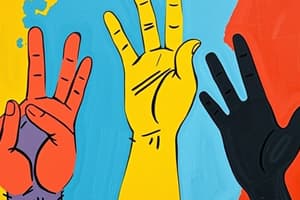Podcast
Questions and Answers
What was the primary reason Thomas Gallaudet traveled to Europe in 1815?
What was the primary reason Thomas Gallaudet traveled to Europe in 1815?
- To escape religious persecution in the United States.
- To teach English to deaf students in Europe.
- To establish a trade route for educational materials.
- To assess and learn different methods of deaf education. (correct)
Why might the English school have been unwilling to share their teaching methods with Gallaudet?
Why might the English school have been unwilling to share their teaching methods with Gallaudet?
- They believed the American education system was inferior.
- They were afraid Gallaudet would take their students and their livelihood. (correct)
- They did not believe Gallaudet had the appropriate credentials.
- They were under strict orders from the government not to share educational secrets.
What is a key limitation of lip-reading as identified by opponents of the oral method?
What is a key limitation of lip-reading as identified by opponents of the oral method?
- It requires extensive training and natural aptitude.
- Different sounds can produce similar lip movements. (correct)
- It is only effective in well-lit environments.
- It is not suitable for teaching complex or abstract concepts.
What is a central argument made by opponents of ASL?
What is a central argument made by opponents of ASL?
What core principle underlies the philosophy of total communication?
What core principle underlies the philosophy of total communication?
What was the significance of Shannon Merryman's challenge to participate in the Voice of Democracy contest?
What was the significance of Shannon Merryman's challenge to participate in the Voice of Democracy contest?
In the context of the passage, what does the word 'proponents' mean?
In the context of the passage, what does the word 'proponents' mean?
Why did Abbé Michel de l'Épée develop a simple language with its own vocabulary and grammar?
Why did Abbé Michel de l'Épée develop a simple language with its own vocabulary and grammar?
What does the grammar of American Sign Language (ASL) primarily consist of?
What does the grammar of American Sign Language (ASL) primarily consist of?
What was the name of the first free school for the deaf in the United States, and where was it located?
What was the name of the first free school for the deaf in the United States, and where was it located?
Flashcards
Manual Method
Manual Method
A method of communication using hand and arm movements, developed in France by Abbé Michel de l'Épée.
Oral Method
Oral Method
Teaching people who are deaf to enunciate words and lip-read.
American Sign Language (ASL)
American Sign Language (ASL)
A system using word-like units made with one or both hands to form shapes and movements.
Total Communication
Total Communication
Signup and view all the flashcards
Aver
Aver
Signup and view all the flashcards
Concede
Concede
Signup and view all the flashcards
Basic or simple
Basic or simple
Signup and view all the flashcards
Vociferous
Vociferous
Signup and view all the flashcards
Study Notes
- The ability to communicate thoughts through rudimentary gestures alleviates the feeling of isolation in a totally silent world where no words are spoken or heard.
Development of Language for the Deaf
- In 1755, Abbé Michel de l'Épée developed a simple language with vocabulary and grammar.
- The school founded in Paris taught people who had lost their hearing to communicate through hand and arm movements, known as the "manual" method.
- Simultaneously, a different system developed in England and Germany.
- Proponents of this different system rejected the French method and instead favored teaching the deaf to enunciate words and lip-read, known as the "oral" method.
Introduction to the United States
- In 1815, a group of concerned Connecticut citizens sent Thomas Gallaudet to Europe to assess the manual and oral approaches, because the United States had no schools for the deaf at the time.
- People running the English school were unwilling to share their teaching methods with Gallaudet.
- Gallaudet went to France.
- After living in Paris, he returned to Connecticut to spread the French method.
- Gallaudet opened the first free school for the deaf within a year.
- This school later became the American School for the Deaf in Hartford, Connecticut.
- He used American Sign Language (ASL) there.
- ASL involves signs that are word-like units which use one or both hands to form shapes and distinctive movements.
- The grammar of ASL consists of spatial relations, direction, and orientation of hand movements.
- It shares some elements with spoken English.
- Other schools that taught ASL opened, and for the next few decades ASL predominated in the United States.
Alternative Methods
- In the 1840s, the alternative (oral) method, using actual speech and lip-reading, was introduced at the Clarke School for the Deaf in Worcester, Massachusetts.
- Both methods have generated debates.
- Opponents of speech/lip-reading say that students who have never heard speech cannot duplicate it well enough to understood properly.
- Additionally, lip-reading can be misleading, as examples like "mat", "bat", and "pat" look the same on the lips.
- Opponents of ASL say that students communicate only among themselves and are thus cut off from contact with the rest of the population.
Total Communication and Progress
- In 1969, a large residential school in Maryland introduced the concept of total communication which is influential today because it uses a combination of whatever works for a particular individual.
- Options include speech, lip-reading, signing, mime, gestures, finger spelling, art, reading, writing, and use of electronic media.
- Since the mid-twentieth century, barriers have been removed, aimed towards progress, with federal and state legislation.
- This includes the advocacy of parents and educators, and the challenges of individual citizens.
- An example of progress is Shannon Merryman, a sixteen-year-old Rhode Island high school student who communicated through ASL after losing her hearing at age two.
- When the sponsors of the Voice of Democracy contest rejected her application, she successfully challenged the legality of their act.
- She didn't win the competition, but opened an opportunity for the hearing-impaired to participate in mainstream American life.
- The contest topic that year was "My Voice in America's Future."
Studying That Suits You
Use AI to generate personalized quizzes and flashcards to suit your learning preferences.




